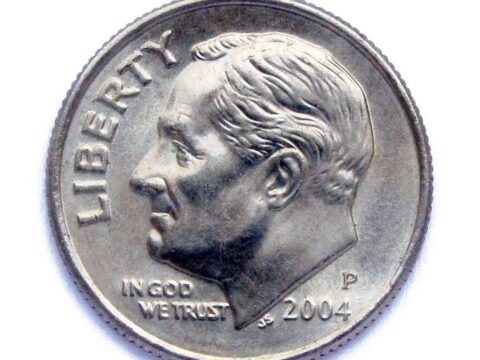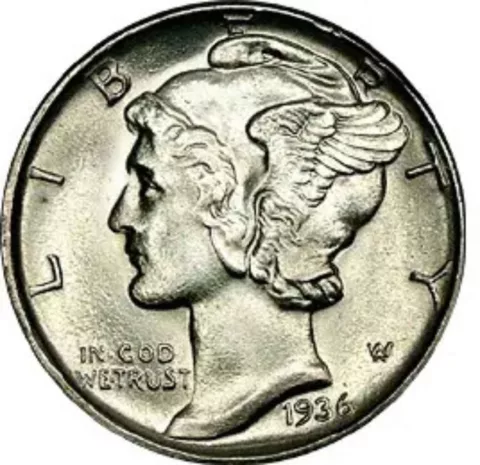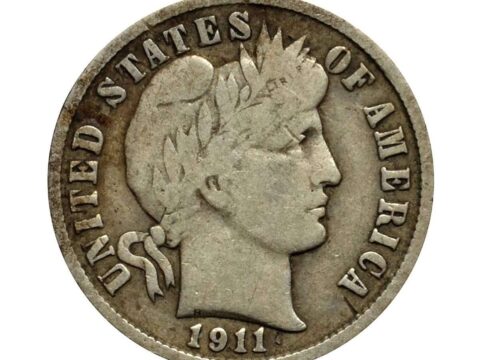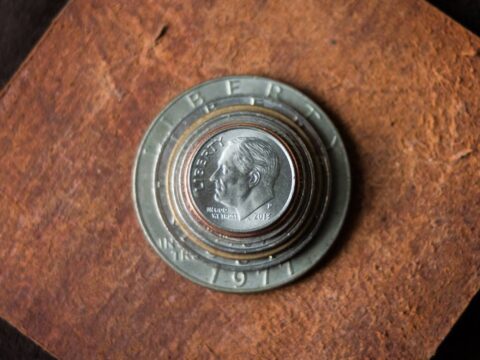How To Grade Dimes
As you know, before you can assign a value to a particular coin, you first need to know the condition (or grade) of that coin.
I’ve previously shared information that will help you get an approximate idea of the grade of your coin.
Now I’m going to go into detail showing you how to obtain exact grades for your circulated U.S. dimes.
There are 3 types of U.S. dimes that I will cover here:
- Roosevelt dimes (1946–present)
- Mercury dimes (1916–1945)
- Barber dimes (1892–1916)
Good To Know: The basic parts of a coin + Coin grade abbreviations and numbers.
Let’s start with the common Roosevelt dime…
Roosevelt Dime Grades

AU-55
- Obverse: Only a trace of wear shows on highest points of hair above ear.
- Reverse: A trace of wear shows on highest spots of the flame. 3/4 of mint luster still present.
AU-50
- Obverse: Traces of wear show on hair above ear.
- Reverse: Traces of wear show on flame but details are sharply defined. Half of mint luster still present.
EF-45
- Obverse: Slight wear shows on high points of hair above ear. Ear is sharp and detailed.
- Reverse: High points of flame are lightly worn. Torch lines are fully defined and clearly separated. Part of the mint luster still present.
EF-40
- Obverse: Wear shows on high points of hair and at cheek line. Ear shows slight wear on upper tip.
- Reverse: High points of flame, torch, and leaves are worn but all details are clearly defined and partially separated. Traces of mint luster may still show.
VF-30
- Obverse: Wear spots show on hair, ear, cheek, and chin. Hair lines are weak but have nearly full visible details.
- Reverse: Wear shows on flame but some details are visible. All vertical lines are plain. Most details in the torch and leaves are clear.
VF-20
- Obverse: 3/4 of details still show in hair. Face worn but bold. Some details in ear are visible.
- Reverse: Wear shows on flame but a few lines are visible. All torch lines are worn but bold. Most details in leaves are clear.
F-12
- Obverse: Half the details show in hair. All of the face is weak but boldly visible. Half of inner edge of ear is worn away.
- Reverse: Vertical lines are all visible but horizontal bands are worn smooth. Leaves show some detail. Flame is nearly smooth.
VG-8
- Obverse: Entire head is weak and most of the details in hair and ear are smooth. All letters and date are clear. Rim is complete.
- Reverse: About half of the outer vertical lines in torch are visible. Flame is only outlined. Leaves show very little detail. Rim is complete.
G-4
- Obverse: Entire design well worn with very little detail remaining. Ear is completely outlined. Legend and date are weak but visible. Rim is visible.
- Reverse: Torch is worn nearly flat but is completely outlined. Leaves are worn smooth. Legend is all visible.
AG-3
- Obverse: Head is outlined with nearly all details worn away. Date readable but worn. Legend merging into rim.
- Reverse: Entire design partially worn away. Rim merges into the legend.
Mercury Dime Grades

AU-55
- Obverse: Only a trace of wear shows on the highest points of hair above forehead and in front of ear.
- Reverse: A trace of wear shows on the horizontal and diagonal fasces bands (bundle of rods tied around an axe). 3/4 of mint luster still present.
AU-50
- Obverse: Traces of wear show on hair along face, above forehead, and in front of ear.
- Reverse: Traces of wear show on the fasces bands but edges are sharply defined. Half of mint luster still present.
EF-45
- Obverse: Slight wear shows on high points of feathers and at hair line. Hair along face is sharp and detailed.
- Reverse: High points of the diagonal fasces bands are lightly worn. Horizontal lines are clearly defined but not fully separated. Part of mint luster still present.
EF-40
- Obverse: Wear shows on high points of feathers, hair, and neckline.
- Reverse: High points of fasces bands are worn but all details are clearly defined and partially separated. Traces of mint luster may still show.
VF-30
- Obverse: Wear spots on hair along face, cheek, and neck line. Feathers are weak but have nearly full details.
- Reverse: Wear shows on the 2 diagonal bands but most details are visible. All vertical lines are sharp. All details in branch are clear.
VF-20
- Obverse: 3/4 of details still show in feathers. Hair worn but bold. Some details in hair braid are visible.
- Reverse: Wear shows on the 2 diagonal bands but most details are visible. All vertical lines are sharp. All details in branch are clear.
F-12
- Obverse: Some details show in hair. All feathers are weak but partially visible. Hair braid is nearly worn away.
- Reverse: Vertical lines are all visible but lack sharpness. Diagonal bands show on fasces but one is worn smooth at midpoint.
VG-8
- Obverse: Entire head is weak and most details in the wing are worn smooth. All letters and date are clear. Rim is complete.
- Reverse: About half of the vertical lines in fasces are visible. Rim is complete.
G-4
- Obverse: Entire design well worn with very little detail remaining. Legend and date are weak but visible. Rim is visible.
- Reverse: Fasces is worn nearly flat but in completely outlined. Sticks and bands are worn smooth.
AG-3
- Obverse: Head is outlined with nearly all details worn away. Date readable but worn. Legend merging into rim.
- Reverse: Entire design partially worn away. Rim worn half way into the legend.
Barber Dime Grades

AU-55
- Obverse: Only a trace of wear shows on highest points of hair below LIBERTY.
- Reverse: A trace of wear shows on ribbon bow, wheat grains, and leaf near O. 3/4 of mint luster still present.
AU-50
- Obverse: Traces of wear show on cheek, top of forehead, and hair below LIBERTY.
- Reverse: Traces of wear show on ribbon bow, wheat grains, and tips of leaves. Half of mint luster still present.
EF-45
- Obverse: Slight wear shows on high points of upper leaves, cheek, and hair above forehead. LIBERTY is sharp and band edges are bold.
- Reverse: High points of wreath and bow lightly worn. Lines in leaves are clearly defined. Part of mint luster still present.
EF-40
- Obverse: Light wear shows on leaves, cheek, cap, and hair above forehead. LIBERTY is sharp and band edges are clear.
- Reverse: High points of wreath and bow are worn but all details are clearly defined. Traces of mint luster may still show.
VF-30
- Obverse: Wear spots show on leaves, cap, hair, and cheek. Bottom row of leaves is weak but has some visible details. LIBERTY and band are complete.
- Reverse: Wear shows on the 2 bottom leaves but most details are visible. Nearly all details in ribbon bow and corn kernels are clear.
VF-20
- Obverse: Over half the details still show in leaves. Hair worn but bold. Every letter in LIBERTY is visible.
- Reverse: The ribbon is worn but some details are visible. Half the details in leaves are clear. Bottom leaves and upper stalks show wear spots.
F-12
- Obverse: Some details show in hair,cap,and facial features. All letters in LIBERTY are weak but visible. Upper row of leaves is outlined but bottom row is worn smooth.
- Reverse: Some details in the lower leaf clusters are plainly visible. Bow is outlined but flat. Letters in legend are worn but clear.
VG-8
- Obverse: Entire head weak and most details in face worn smooth. Three letters in LIBERTY are clear. Rim is complete.
- Reverse: Wreath shows only a small amount of detail. Corn and grain are flat. Some of the bow is very weak.
G-4
- Obverse: Entire design well worn with very little detail remaining. Legend is weak but visible. LIBERTY is worn away.
- Reverse: Wreath is worn flat but completely outlined. Corn and grains are worn nearly smooth.
AG-3
- Obverse: Head is outlined with nearly all details worn away. Date readable but partially worn away. Legend merging into rim.
- Reverse: Entire wreath partially worn away and merging into rim.
The Bottom Line…

It takes a lot of time and experience to consistently grade coins accurately, but you’ll never get there if you don’t start somewhere. Hopefully you’re able to grade your Roosevelt dimes, Mercury dimes, and Barber dimes better now.
Grab a coin magnifier and a copy of the U.S. Coin Grading Standards book. Then, watch this video to see how to grade coins yourself at home:



